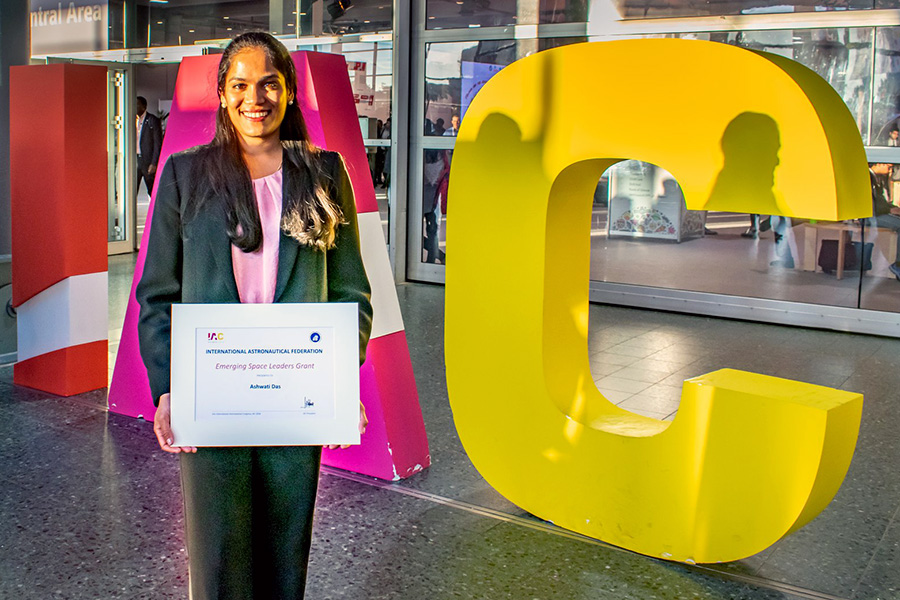AAE student awarded Emerging Space Leaders Grant

AAE Ph.D. student Ashwati Das was one of 25 students and young professionals awarded an Emerging Space Leaders Grant.
Das was chosen by the Emerging Space Leaders Steering Committee to attend the International Astronautical Congress (IAC) and the Space Generation Congress in Bremen, Germany in October.
The application process for the Emerging Space Leaders Grant (ESLG) included several essays outlining the applicant’s academic and non-scholastic contributions to the space industry as well as a short video that explained why the applicant deserved the award.
Das says she was “ecstatic” to earn the grant.
“It pays for travel, so it meant that I could actually go to this conference, but more than that, I was very honored to be recognized by the IAF for my contributions,” she says.
Among Das’s accomplishments that caught the eye of the ESLG is her leadership of the Purdue Mars student organization. As the prior President of Purdue Mars, Das worked with her team to organize forums, speaker sessions, and networking events to create awareness of space endeavors on campus and encourage inter-departmental collaborations. She also helped facilitate student teams for analog astronaut expeditions and conducted outreach at local schools to inspire the younger generation.
Das, a Ph.D. student of Hsu Lo Distinguished Professor of Aeronautics and Astronautics Kathleen Howell, works on blending machine learning and artificial intelligence with traditional trajectory design techniques. Trajectory design involves transporting humans or spacecraft and cargo between different planetary destinations.
“If you want to go from Point A to Point B, there could be infinitely many options. Using manual techniques, which we have today, it can be quite time consuming, especially with limited resources,” she says. “Our human intuition is an advantage for informing the transfer design, but then it is also helpful to use machine learning to churn through a very large trade space so that we can choose from a reduced set of alternatives and see what might be best for our mission. The aim is to enable humans to focus on more interesting things than on time-consuming calculations.”
She has also interned with NASA’s Jet Propulsion Laboratory on mission design alternatives for the Mars Sample Return and Europa Lander mission concepts, with NASA Marshall on evaluating space system architecture alternatives, and collaborated with NASA Goddard on her PhD research topic.
These technical and professional achievements are also heavy factors when evaluating candidates for the ESLG, helping applicants like Das to stand out amongst a global cohort of young space professionals.
The ESLG group attended the Space Generation Congress, the annual meeting of the Space Generation Advisory Council (SGAC). SGC is endorsed by the United Nations Office of Outer Space Affairs.
The SGC, held in conjunction with the IAC, facilitates workshops on a variety of space-related topics, including safety, exploration, policy, and commercialization. Over three days, small groups discussed each topic and, ultimately, provided recommendations for the U.N. Das was in the space policy group and was selected as rapporteur, which means she will compile the group’s report for the Committee on Peaceful Uses of Outer Space.
“One day I am at Purdue working away at non-linear programming and the next I have the opportunity to work with a multi-disciplinary and international team to make recommendations on how we can shape space endeavors to address the UN’s Sustainable Development Goals like reducing poverty and improving health around the world. What a wonderful experience,” she says. “Especially because the topic of ‘space’ seems so distant and disconnected in regular conversations. Here we were discussing how we could bridge the gap so that people could understand the tangible benefits of space efforts to solve problems back on Earth. I was just blown away by the experience. We learned so much from each other by sharing lots of diverse and thought-provoking conversations, which we’re unable to have often, as we spend all our time working in our specialized fields.”
At the IAC, Das presented her research, attended sessions, and took advantage of networking opportunities, meeting some of the world’s leaders in aerospace engineering.
“The program was amazing,” says Das, who also attended the IAC last year in Australia. “There’s a lot of face time with very inspiring and self-made world leaders in the industry. You’re getting to interact and learn how they navigated their lives to make an impact in this world. In addition to presenting your work, you get to learn what other people are doing in research, the struggles and triumphs of kindling new businesses and markets, and the political decisions that help shape the global aerospace industry. The IAC is really a vehicle that presents easy access between decision makers, engineers, and students alike, and encourages collaborations. It was just unbelievable to be rubbing shoulders with some of the greatest influencers in the world.
“Coming out of this conference and the SGC, the biggest thing for me is that I know there’s a pathway for me to make an impact in this industry. At the conference, I was not only inspired by the influential people who are leading international space agencies but also by my peers who are taking risks and working hard to make significant contributions. All this technical knowledge in graduate school, I hope it’ll help me be a credible and dependable leader, be technically sound, but I also want to start learning more about the policy and business side so that I can help influence the decisions that are made, to grow the industry.”
